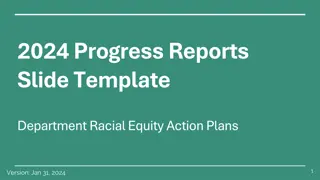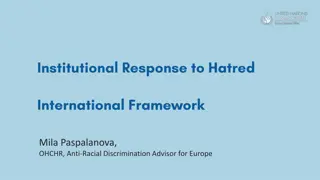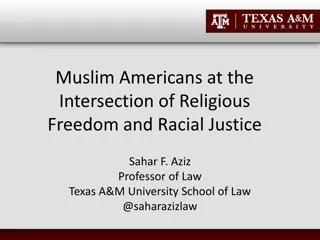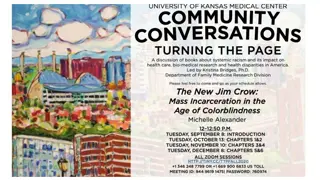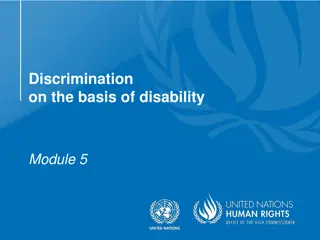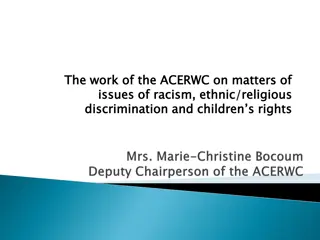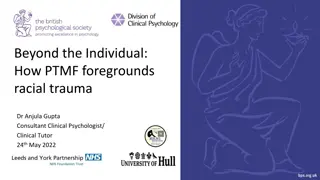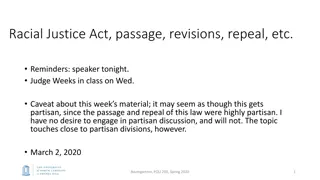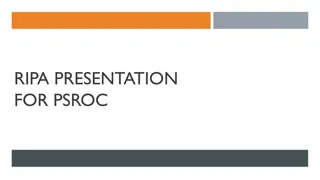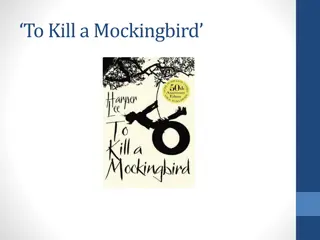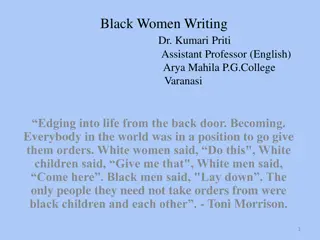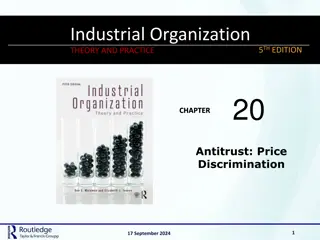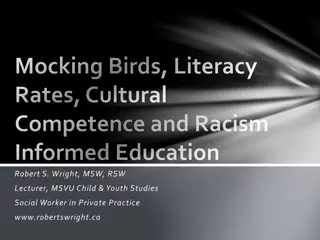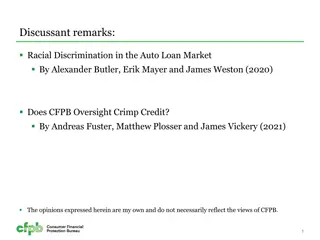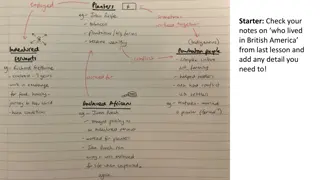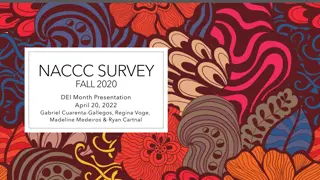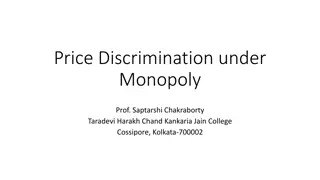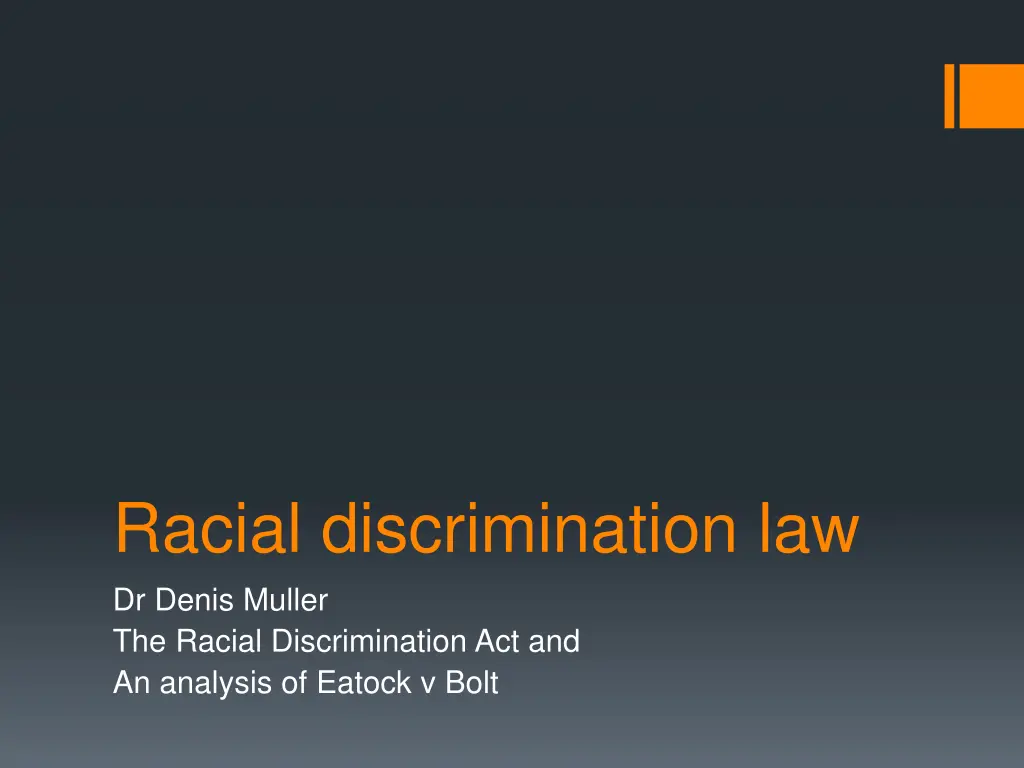
Analysis of Racial Discrimination Law in Eatock v. Bolt Case
Explore the legal implications of racial discrimination under the Racial Discrimination Act, focusing on the landmark case of Eatock v. Bolt. Understand the nuances of Section 18C and its exceptions, particularly in relation to journalism. Dive into the facts of the case, the offending material, and the implications for future discourse on racial identity and public interest journalism.
Download Presentation

Please find below an Image/Link to download the presentation.
The content on the website is provided AS IS for your information and personal use only. It may not be sold, licensed, or shared on other websites without obtaining consent from the author. If you encounter any issues during the download, it is possible that the publisher has removed the file from their server.
You are allowed to download the files provided on this website for personal or commercial use, subject to the condition that they are used lawfully. All files are the property of their respective owners.
The content on the website is provided AS IS for your information and personal use only. It may not be sold, licensed, or shared on other websites without obtaining consent from the author.
E N D
Presentation Transcript
Racial discrimination law Dr Denis Muller The Racial Discrimination Act and An analysis of Eatock v Bolt
The RDA S18C It is unlawful for a person to do an act that is: (a) reasonably likely to offend, insult, humiliate or intimidate another person or a group of people; and (b) done because of the race, colour or national or ethnic origin of the other person or group.
The RDA S18D Section 18C does not render unlawful anything said or done reasonably and in good faith: (a) in the performance . . . of an artistic work; or (b) in the course of any statement, publication, discussion or debate made or held for any . . . genuine purpose in the public interest; or (c) in making or publishing: (i) a fair and accurate report of any event or matter of public interest; or (ii) a fair comment on any event or matter of public interest.
Implications for journalism The journalism must be reasonable and done in good faith The protection for journalism that meets these criteria applies to both reportage and commentary The journalism must concern a matter of public interest This is not defined but is considered to be broadly defined, and would certainly include matters such as the award of government grants or appointments to government positions. These were matters on which Andrew Bolt was commenting, and the court did not find against him on this.
Eatock V Bolt: The facts In 2009, Andrew Bolt published a series of columns and blogs in the Herald Sun implying that people were choosing to identify as Aboriginal in order to benefit from certain grant money and other advantages. He was sued by Ms Pat Eatock, an Aboriginal woman. The case was tried in the Federal Court before Bromberg J.
The offending material Articles It s so hip to be black White fellas in the black Blogs One of these women is Aboriginal Aboriginal man helped
A sample of the Bolt material Headline: It's so hip to be black MEET the white face of a new black race -- the political Aborigine. Meet, say, acclaimed St Kilda artist Bindi Cole, who was raised by her English-Jewish mother yet calls herself ``Aboriginal but white''. She rarely saw her part-Aboriginal father, and could in truth join any one of several ethnic groups, but chose Aboriginal, insisting on a racial identity you could not guess from her features. She also chose, incidentally, the one identity open to her that has political and career clout. And how popular a choice that now is. Ask Annette Sax, another artist and -- as the very correct Age newspaper described her -- a ``white Koori''. Her father was Swiss, and her mother only part-Aboriginal. Racially, if these things mattered, she is more Caucasian than anything else. Culturally, she's more European. In looks, she's Swiss.
Ms Eatocks claims It was reasonably likely that she and people like her were offended, insulted, humiliated or intimidated by the articles, and The material was published because of her race, colour or ethnic origin
Bolts response The meanings claimed by Ms Eatock were not in the articles No offence was likely to be caused Race, colour or ethnic origin had nothing to do with the decision to publish
Principles applied by the court That the meaning is reasonably capable of being conveyed without any strained or forced or utterly unreasonable interpretation. That meanings can be literal or implied. That the capability of the material to reasonably convey particular meanings is assessed on the basis of what the ordinary reasonable reader will take from it, drawing on his or her own knowledge and experience of human affairs.
The ordinary reasonable reader The ordinary reasonable reader is a person of fair average intelligence who is neither perverse, nor morbid or suspicious of mind, nor avid for scandal. That person does not live in an ivory tower but can and does read between the lines in the light of that person s general knowledge and experience of worldly affairs.
Meanings claimed by Ms Eatock People of Aboriginal descent with fairer rather than darker skins are not genuinely Aboriginal. They pretend to be Aboriginal persons so they can get benefits that are only available to Aboriginal persons. The only genuine Aboriginal persons are persons whose parents are both of Aboriginal descent and who have darker rather than fairer skin.
Meanings claimed by Bolt & HWT There was a discernible trend in Australia whereby persons of part-Aboriginal genealogy identify as Aboriginal persons, where they could instead identify with another race or no race. (b) That this trend was undesirable because it emphasizes racial differences, rather than common humanity.
Meanings found by Bromberg J (1) There are fair-skinned people in Australia with some Aboriginal descent who are not sufficiently Aboriginal to be genuinely identifying as Aboriginal Fair skin colour indicates a person who is unlikely to be genuinely identifying as an Aboriginal person.
Meanings found by Bromberg J (2) That people who are not really Aboriginal are taking benefits that were intended for real Aboriginal people That there is a connection between the people constituting the trend identifying as Aboriginal and those people obtaining personal advantage That personal advantage is a motivating factor in the alleged choice [of genealogy] made.
Key principles in the judgment What meanings were conveyed by the articles complained of? Were the articles defensible as fair comment? Was the conduct of Bolt and HWT in publishing the material reasonable and performed in good faith?
Finding on meanings The court found for Ms Eatock and against Bolt and the HWT on meanings
Finding on fair comment Bolt failed the test of fair comment because: His comments were based on facts that were not true, in fact substantially untrue He selectively omitted facts that were inconvenient to his argument
Finding on reasonableness Bolt and HWT fell foul of two elements in this test of reasonableness: they did not make diligent inquiries as to the facts, and they did not give the people named an opportunity to respond prior to publication.
Finding on good faith Bolt failed the test of good faith because: He used language that was inflammatory, provocative, mocking and derisive, often cynical and containing gratuitous references to colour and, in one case, to a person s sexuality. Bolt would probably have lost a defamation suit for these reasons
Link to defamation law Some of the meanings found by Bromberg J to be conveyed by Bolt were clearly defamatory: That the people claiming to be Aboriginal people were not genuine Aboriginal people: that they were fraudulent & dishonest That they are taking benefits from people who are genuinely entitled to those benefits: that they are fraudulent & dishonest That they did this for personal advantage: that they are greedy
The real issue for free speech Some of the thresholds in the RDA offend, insult are very low when compared with defamation law thresholds. The question for Parliament is whether they are set at the correct level for the purposes of the Act, and whether they strike the right balance between free speech and the protection of people from discrimination.
An attempted solution In March 2107 the Federal Government presented a Bill to Parliament. It replaced insult , offend and humiliate with harass . That would have set the bar much higher. It would also have been vague and difficult to prove which was the idea behind it. It was defeated in the Senate. So the current Sections 18C and 18D stand.

